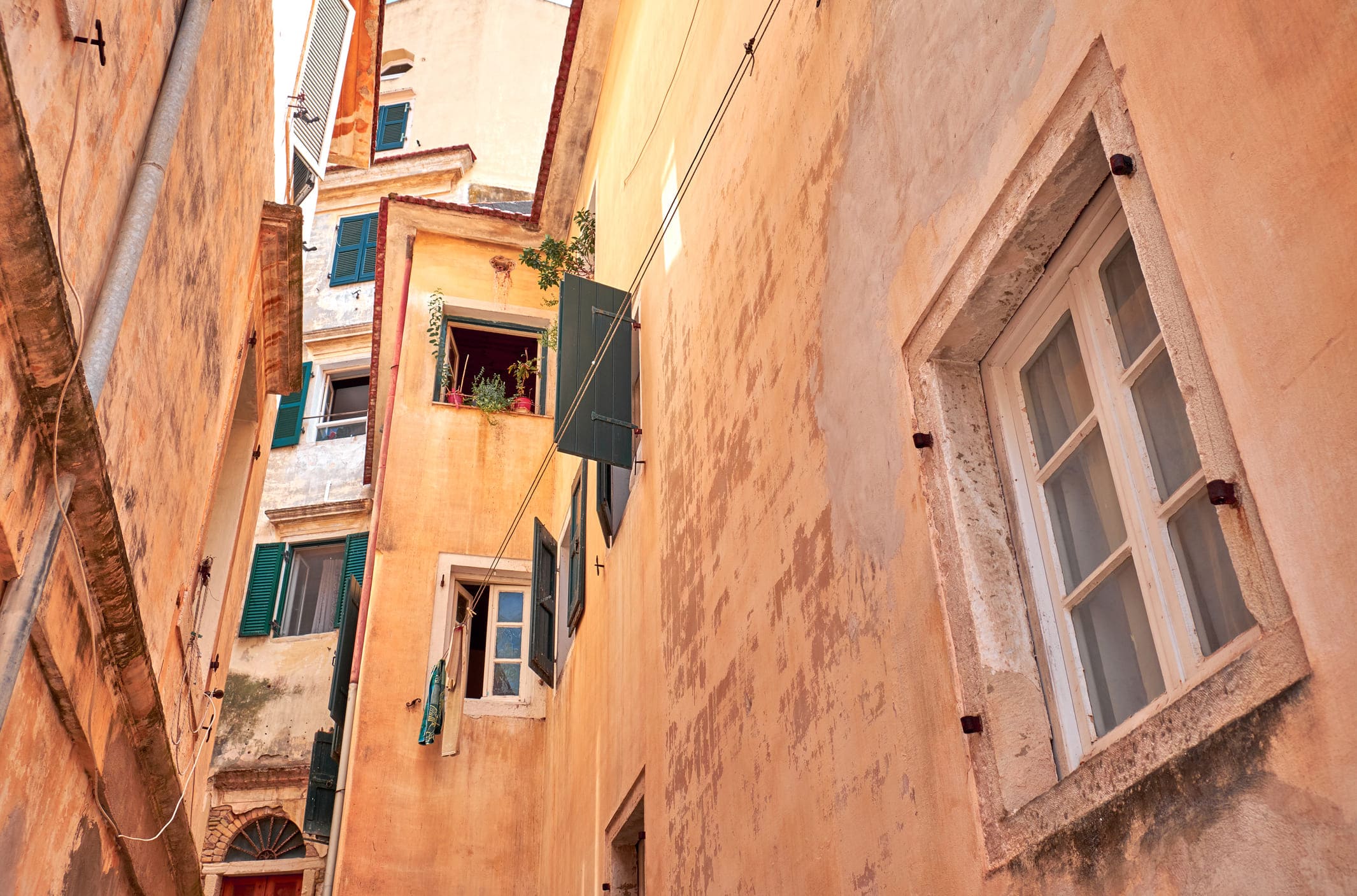Corfu isn’t just stunning beaches and resorts, oh no! Fancy strolling through the town and finding out a little more about the cultural heritage of this magnificent island? Here are a few recommendations for sightseeing around Corfu Town and the surrounding areas.
With almost 30,000 residents, Corfu Town is home to a third of the population of the regional unit of Corfu (Corfu, Paxoi, Antipaxoi, Othonoi, Ereikoussa and Mathraki). It’s divided into the old town (Xopoli, between the old and new citadels) and three modern suburbs: Mantouki to the north-west, Saroko between the hills of Avrami and Sotiros, and Garitsa, which begins at the Douglas Column to the south. The historic centre is in the old town, the ramparts of which have prevented it from spreading, resulting in its unique architecture, with tall houses rising up over several floors, narrow alleyways (kantounia) where the locals hang their laundry out to dry, and little squares. It is the largest preserved medieval town in Greece and one of the most beautiful in the Mediterranean, being listed as a UNESCO World Heritage Site since 2007.
Here’s a small selection of places not to be missed, if you decide to explore Corfu in more detail:
• The Spianada (Esplanade). The town’s central square, one of the largest and most impressive in the country. It was designed in the 17th and 18th centuries, when, as part of fortification work to protect the city, the Venetians opened the “Spianata” – occupying an area that at that point took up a third of the town- in front of the old citadel, so as to create a large firing range for defenders in the event of attack. It’s the most popular promenade for locals and visitors, and it’s here that most events take place, such as concerts, processions, parades, and cricket matches (on the lawn). Opposite is the Pentophanaro, ideal for skateboarding, the monument of the Union of the Heptanese, the Venetian Cistern and the bandstand where orchestras give concerts.
• The Liston, one of the most famous features of the Spianada, with its instantly recognisable arches. It was built by a French engineer, Lesseps, during the French Empire’s administration of the island and modelled on the Rue de Rivoli in Paris. A series of bakeries, coffee shops and boutiques give it a cosmopolitan look and make it a meeting place.

• The palace of St. Michael and St. George, a large Georgian building built between 1819 and 1823. This richly decorated palace, with its magnificent gateways and a Doric colonnade, served as a seat for the English delegates of the Ionian Senate and the order of St. Michael and St. George. It now houses the sizeable Museum of Asian Art, which has around 10,500 pieces of art from India, China, Korea, Pakistan, Japan, and more (coming from private donations), as well as the Municipal Art Gallery, which mainly exhibits works by nineteenth- and twentieth-century Corfu artists.
• The Reading Society, the oldest intellectual institution in modern Greece.
• The gate of Agios Nikolaos (Saint Nicholas). Opposite the Reading Society, below the main road, lies the small bay of Faliraki and the Corfu’s famous – formerly private – beach, “Alekos baths”.
• Mouragia, one of the most beautiful parts of town. There, take Arseniou Street, which starts at the old port and ends at the palace of St Michael and St George, in the central square. In this district (1 Arseniou Street) you’ll find the Dionysios Solomos Museum in the house where the poet and author of the “Hymn to Liberty”, the words of which became the Greek national anthem, lived for around thirty years until his death in 1857.

• The Old Citadel, built on a peninsula near the Spianada. For defensive reasons, the Contra Fossa moat was dug to turn the peninsula into an island. The fortification begun by the Byzantines was continued by the Venetians. It is linked to the city by an impressive bridge. The citadel’s most important monuments are the central gate, the bastions of Savorgnan, Martinego and Mandraki, the towers of the land and the sea, Agios Georgios church (1840), a basilica modelled on an ancient Doric temple, a Catholic chapel, the old prisons, the English barracks and the English hospital. You can also see the lighthouse, the clock tower, the Municipal Central Library and the Historical Archives.
• Campiello, the oldest district of Corfu, with the Panagia Kremasti church and a square with a Venetian well.
• Kanoni, one of the most touristy places in Corfu, with a splendid view of the Vlacherna Monastery, Pontikonisi, the Chalikiopoulou Lagoon and the airport.

• Pontikonisi, a small island that has become the symbol of Corfu and which, according to mythology, is a fossilised Phaeacian ship.
• Mon Repos (3km to the south). A visit to this splendid estate is essential. The neoclassical building was the summer residence of the former Greek royal family. The villa, originally built to house the English Commissioner Sir Frederick Adam and his wife, Diamantina Palatianou, a Corfu local, is a masterpiece of 19th century neoclassical architecture. The small yet interesting Archaeological Museum of Palaiopolis can be found there.
• Palaiopolis, an archaeological site near Mon Repos. This is the agora of ancient Kerkyra (Corfu). It’s worth seeing the Temple of Apollo (in Mon Repos, near the ruins of the Temple of Hera), the Roman baths, the agora and a construction from the end of the Hellenistic period.

One thing is certain, if you’ve had enough of boat trips, water sports, white sandy beaches and turquoise water… Corfu can also offer you vast cultural heritage to be discovered on beautiful strolls.



